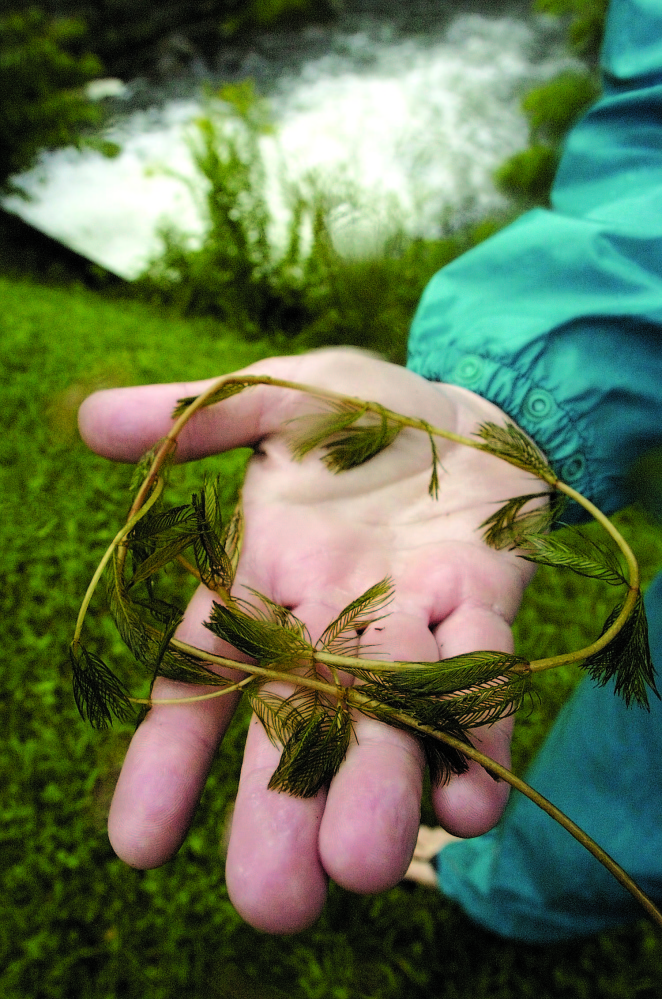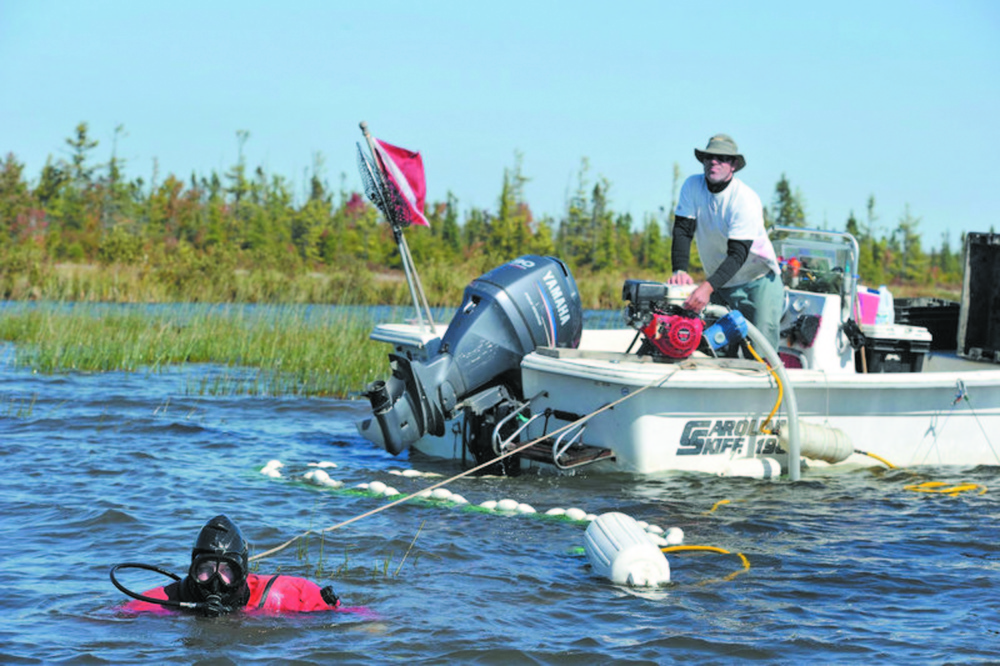Cough up the dough, or the lake dies.
That’s not quite how local lakes associations are putting it, but as they ask area towns to help fund a fierce war against an invasive plant, the connection between the money and lake health is clear.
The enemy is milfoil, a quick-growing, quick-spreading weed that runs rampant over native plants and has no natural predators. Left unchecked, it fills shorelines with mats of thick, green fronds that render a lake unsuitable for swimming or boating.
Lakes groups like the Belgrade Regional Conservation Alliance and the Belgrade Lakes Association are leading the charge against milfoil in the Belgrade-area lake system.
It’s a war they say they can win, but in order to do so, they need money, not just from private donors and government grants, but from local property taxpayers, who they say have everything to lose.
That’s why this spring, more area voters than ever are being asked during town meeting to spend thousands on milfoil eradication.
In the past, the lakes groups have sought only minimal funding from towns, according to Charlie Baeder, executive director of the Belgrade Regional Conservation Alliance.
But there’s been a shift in thinking.
“We’ve been careful in not asking for too much money,” Baeder said, “but one of our ideas going forward is that we want to make sure that we’re asking for enough money to do the job.”
Milfoil eradication isn’t cheap. The groups have spent hundreds of thousands of dollars per year the past couple years, and this year will be no different.
Baeder said the end of six-figure expenditures is in sight, but town support is needed to get to the finish line, or much of the money spent to date will have been wasted.
Over the past year, Baeder said he’s gone to about 40 meetings in the community, and has had face-to-face conversations with more than 1,000 people.
Many of those discussions have taken place in Belgrade, which has spent more than any other town to battle milfoil, and which will be asked on Friday’s town ballot to spend more this year.
In 2013, the town spent $3,100 for the boat inspections and $6,800 for a Youth Conservation Corps program that does shoreside projects to improve lake health. Selectmen also approved spending $20,000 from a water quality improvement fund for the milfoil project.
In the past, residents have voted on the requests in open meeting, but this year, those sums and more will be on a secret ballot in Friday’s town election.
In the March town newsletter, Town Manager Greg Gill said “because of the amount being so high the board decided to place all the requests on the secret ballot and let the residents decide if they wanted to fund them or not.”
He added that besides the money not being available in reserve, “the board also feels that other surrounding towns should be allocating funds towards some of the requests so they are not all funded by Belgrade taxes.”
The ballot includes the $20,000 request for the BLA’s STOP Milfoil program in Great and Long ponds, as well as a BRCA request for $10,000 to support milfoil removal in Belgrade Stream and Messalonskee Lake, part of the effort to keep milfoil out of Long Pond. That request would be matched by a U.S. Fish and Wildlife grant.
The Friends of Messalonskee, another lake association, is also approaching Belgrade for the first time, seeking $5,000 to remove milfoil from Messalonskee Lake along Route 27 and Belgrade Stream where it connects to the lake near the boat landing.
Between the three items, voters are being asked to approve $35,000 in expenditures that they weren’t asked to consider last year.
And the town is also voting on $3,5000 for inspections and $6,800 for the YCC projects by secret ballot.
Baeder said the Town Meeting format allowed him to speak on behalf of the proposals and answer questions.
“Our concern this year is that there isn’t any opportunity to have that conversation with the voters,” Baeder said.
BATTLE ESCALATION
Ever since invasive milfoil was first discovered in the United States in the 1960s, it has hopped from lake to lake, spreading throughout most of the country. The plant typically hitchhikes from one body of water to the next on a boat’s propellers, anchor lines, trailer, bait buckets or fishing gear.
The state in 2002 began requiring all inland motorized watercraft to display a “milfoil sticker.” Proceeds for the sticker go to eradication.
The state also imposes tough fines for boats that bring milfoil to lakes — there is a $500 fine transporting a boat that has milfoil on it and up to $5,000 for launching one.
Milfoil was first discovered in the region in Great Meadow Stream in 2010, said Lynn Mattson, co-chairman of the Stop Milfoil Taskforce at the Belgrade Lakes Association.
The stream connects North Pond in Rome to the northern end of Belgrade’s Great Pond.
In 2010, volunteers organized by the BLA pulled 600 gallons of the plant out of the water. In 2011, they pulled more than twice that, 1,500 gallons.
But the milfoil was just getting started. Even as the volunteers worked, it was creeping into the North Bay of Great Pond.
Milfoil is great at spreading, one of the things about the plant that gives environmentalists nightmares.
When a volunteer pulls a milfoil plant out of the mud, it is easy for small fragments to break off and float away. As they land on the lake bottom, they set down new roots, becoming new plants. Because of this, pulling one plant can lead to the creation of dozens of new plants, scattered throughout the lake.
Despite the best efforts of the volunteers, by 2011 the milfoil had spread farther down Great Meadow Stream. It was time to bring in the professionals, Mattson said.
New England Milfoil, a Brownfield-based company, brought specialized equipment to the fight. It uses underwater vacuum devices that suck up every little plant fragment plant, large black mats that deprive nascent plants of sunlight and a crew of licensed scuba divers, resources that are effective, but costly.
In 2012, the company sucked 50,000 gallons of the stuff out of Great Pond and Great Meadow Stream, enough to cover an area the size of an Olympic swimming pool with a layer six inches deep. The cost was $200,000.
At the same time, the lakes groups hired boat inspectors to check for milfoil on thousands of boats at launches. An adopt-a-shoreline program spread public awareness by asking groups and individuals to monitor their own corners of the lake for signs of milfoil.
Now, 17 road associations and 121 volunteers prowl 11 miles of about 50 miles of total frontage on Great Pond and Long Pond.
The programs were successful. By fall of 2012, a survey showed the amount of milfoil in the lake was down 90 percent. But the remaining 10 percent, more than enough to regrow and conquer new territory throughout the lake, was as problematic as ever.
In 2013, New England Milfoil sucked 30,000 more gallons of milfoil out of the waters. Another 10,000 gallons were removed from a handful of other areas in the lakes system — an unofficial boat launch on Bartlett Road in Belgrade, an area near Wings Mill Dam at the outlet of Long Pond in Belgrade Stream, a section of Messalonskee Lake.
That effort came with another $200,000 price tag, which was paid for mostly with a hodgepodge of private donations, grants and town support. Belgrade contributed $20,000; Rome, $10,000. The US. Fish and Wildlife Service chipped in $40,000 because the lakes provide one of the only nesting grounds for the state’s 90 pairs of the endangered black tern.
EXPENSIVE PROBLEM
Mattson said that level of expense is not sustainable.
“We’re going to have another aggressive plan this year, bringing it down to the 15,000 to 18,000 (gallon) range,” Mattson said. “In a couple years, you should be at the point where you could go in early in the year and remove the new plants in a very cost-effective way.”
That’s the exit strategy for the lake groups — a scenario that will let them send home the hired guns and draw down the troops.
They know they can never get 100 percent of the milfoil out of the lakes — a goal the Maine Department of Environmental Protection called virtually impossible. But if the lakes groups can get it under control, they say they can be preventive, identifying and attacking small patches of milfoil before they bloom into a million-dollar headache.
There’s a conundrum inherent in battling milfoil.
Young milfoil is easy to remove, but hard to see. By the time it’s easy to see, it’s hard to remove.
The answer to the problem, the lakes groups say, is to get more eyes looking for milfoil in more places. That’s where public education comes in.
When an individual spots milfoil and calls it in, the lake groups send people out to verify the sighting.
“If you catch it early, it’s not that big a deal to remove,” Mattson said.
Baeder said an effective maintenance plan on Great Pond would cost somewhere between $20,000 and $40,000 a year, a long-term cost he feels is sustainable.
TOWN MONEY
While the lakes groups have been working to drum up support, some town officials say their finances are too strained to contribute what the lakes groups have asked for.
Baeder and Mattson have been busy asking anyone who will listen for help.
Besides Belgrade’s $45,000-plus in secret ballot requests, other towns are considering higher requests.
On March 22, Sidney voters will also be asked to spend more on the lakes. Last year, they approved $1,100 for the Youth Conservation Corps and $1,000 for milfoil removal. This year, the BRCA has requested an additional $1,000 for milfoil removal; the $3,100 has been recommended for approval by town officials.
In other towns, officials have recommended against fully funding the milfoil battle.
Rome, Mattson’s home, showed strong support for a $10,000 anti-milfoil expenditure last year.
“The vote was unanimous, save one voter,” he said.
But this year, the town’s budget committee recommended halving the amount, to $5,000, for the milfoil battle in Great Meadow Stream and Great Pond.
Both the $10,000 request, and the $5,000 recommendation will be presented as options to voters during their town meeting.
Selectwoman Lesly Real said the decision will be up to the voters, but that she supports an aggressive milfoil campaign.
“I like fishing myself, and trying to get a canoe down Great Meadow Stream was getting to be a little rough,” she said.
Still, Real said she knows some people will oppose it.
“You always have that handful that just don’t want to spend money on anything,” she said.
In Oakland, the lake groups’ efforts to ratchet up financial support hit a snag Wednesday, when town officials submitted a budget that rejected an increase in milfoil eradication funding.
Last year, the town spent a total of $8,000 on local conservation groups, including the East Pond Association, Friends of Messalonskee, the Salmon Lake Association, the Conservation Corps and the boat inspection program.
This year, the recommendation is to spend the same amount, despite requests from the BRCA for an increase from $500 to $1,000 for the inspection program and for an additional $1,000 for milfoil eradication efforts.
Oakland town leaders were initially supportive of the increase, but it was cut from the proposed budget last week, when a goal of a flat budget for the town won out.
Town Manager Peter Nielsen said the flat budget required cutting several things, including road projects and allocations to other nonprofit groups in the area.
Oakland Town Council member Dana Wrigley said the state’s poor economic climate has motivated him and others involved with the budget process to protect taxpayers from property tax increases as much as possible, even when it means giving less to laudable nonprofit organizations like the lakes groups.
For those who watch their environmental presentations with one eye firmly on the town’s purse strings, Baeder and Mattson also make a financial argument on behalf of the milfoil expenditures.
“If these lakes become overrun with milfoil, you’re not going to be able to swim on them,” Mattson said. “You’re not going to be able to boat on them.”
And the ability to swim and boat on the lake, he said, is what makes the region a desirable place to live and visit.
“It stands to reason that property values near a lake choked with milfoil is going to be affected,” Baeder said.
According to a 2010 study of Vermont’s milfoil woes published in the journal Ecological Economics, milfoil can cause lakefront property value to decrease up to 16 percent. The study noted that it did not measure the losses of nearby property values, or the loss of those who recreate on the water.
In towns like Rome and Belgrade, nearly two-thirds of the tax base comes from lakefront property, he said. When that portion of the tax base goes down, the lost dollars have to be made up for by raising taxes on everybody, including those who live away from the lake, Baeder said.
“Officials understand the need to protect this resource,” he said. “The alternative is just unacceptable.”
Matt Hongoltz-Hetling — 861-9287 mhhetling@centralmaine.com Twitter: @hh_matt
Send questions/comments to the editors.





Success. Please wait for the page to reload. If the page does not reload within 5 seconds, please refresh the page.
Enter your email and password to access comments.
Hi, to comment on stories you must . This profile is in addition to your subscription and website login.
Already have a commenting profile? .
Invalid username/password.
Please check your email to confirm and complete your registration.
Only subscribers are eligible to post comments. Please subscribe or login first for digital access. Here’s why.
Use the form below to reset your password. When you've submitted your account email, we will send an email with a reset code.